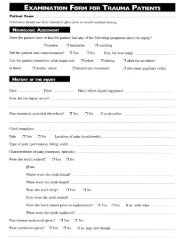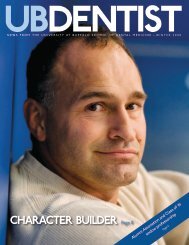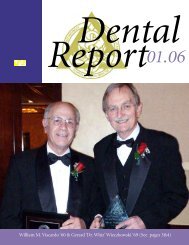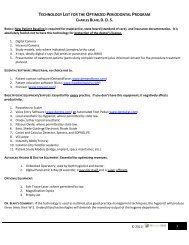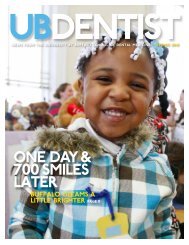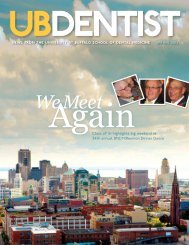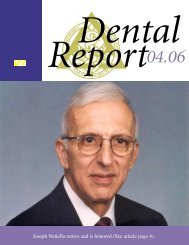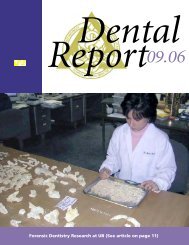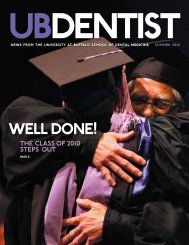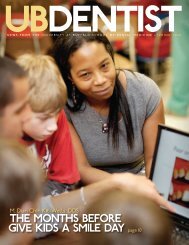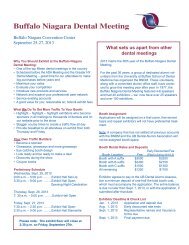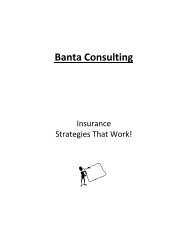Create successful ePaper yourself
Turn your PDF publications into a flip-book with our unique Google optimized e-Paper software.
who practices in Damascus, came to <strong>UB</strong><br />
for implantology coursework 10 years<br />
ago. There can be no more meaningful<br />
endorsement than to encourage the son<br />
to follow.<br />
In the summer before they start the<br />
program, residents spend four weeks in<br />
what Preston calls orthodontics boot<br />
camp, an intensive training course run<br />
by Great Lakes Orthodontics at their<br />
facilities in Tonawanda. “When the<br />
residents come in, they’ve been through<br />
the wringer,” Preston says. The session<br />
gives faculty a good fix on skills levels of<br />
the incoming residents. Preston says he<br />
doesn’t know of any other department<br />
that offers this kind of jump-start.<br />
When they begin the program proper,<br />
residents get more intensive “wire bending”<br />
bench training from a specialist<br />
who comes in from Japan for six weeks.<br />
New residents work up prospective patients<br />
for about six months before they<br />
start treating cases.<br />
New patients are screened for underlying<br />
conditions that would interfere with<br />
treatment. Most patients are teenagers<br />
or pre-teens. If they and their parents<br />
agree to treatment, the work-up includes<br />
X-rays, impressions (from which digital<br />
models are rendered) and extensive photographs<br />
of teeth and face. This material<br />
is digitally mapped and manipulated and<br />
eventually collated in a portfolio that is<br />
the documentation for a treatment plan<br />
that residents and faculty work on.<br />
The program was lengthened from 30<br />
to 36 months in 2007. The curriculum<br />
and clinical training—and a written<br />
examination at the end of year two—<br />
fulfill the requirements for admission to<br />
the American Board of Orthodontics.<br />
Residents see patients three and a half<br />
days a week and spend the balance of<br />
their time on the academic curriculum,<br />
their master’s research and teaching in<br />
the DDS program.<br />
Because orthodontic treatment often<br />
lasts longer than a resident’s training,<br />
third-year residents hand off their cases<br />
to first- and second-years. This formalized<br />
process, which involves faculty, is<br />
an opportunity for collaboration, which<br />
is the pervasive spirit in the clinic.<br />
Each resident starts about 35 cases and<br />
eventually carries a patient load of about<br />
125. Stanislowsky, now halfway through<br />
the program, has appointments booked<br />
eight weeks out.<br />
When Preston characterizes the department,<br />
which he has headed long enough<br />
to leave his stamp, he says that clinically<br />
it is very technique-oriented— “I come<br />
from that background,” he says—and<br />
that it does an impressive amount of<br />
research for its size.<br />
Second-year residents<br />
Michelle Stanislowsky<br />
and Waseem Kassas with<br />
Paul Ziarnowski, clinical<br />
assistant professor, in<br />
the orthodontics clinic.<br />
<strong>Dental</strong> school dean Richard Buchanan<br />
credits Preston for the department’s<br />
significant scholarly production that he<br />
says enhances and enriches its clinical<br />
training. “The department is well recognized<br />
within the school and around the<br />
nation,” he says.<br />
The clinic is<br />
small enough “ i learn as much<br />
to be a<br />
as i give. i learn<br />
real community,<br />
one every day here.”<br />
that is both<br />
–paul Ziarnowski<br />
stable and<br />
continually renewing itself as residents<br />
enter and finish. And, Preston says, the<br />
international residents’ different cultural<br />
perspectives are a wonderful benefit.<br />
After they have finished, graduates of<br />
the program tend to scatter. “Thay<br />
have a good idea where they want to go<br />
before they come here,” Preston says. He<br />
guesses that half a dozen have stayed in<br />
the area over the past 10 years.<br />
But wherever they go, Preston holds the<br />
alumni community together with bonds<br />
of friendship and professional courtesy:<br />
he’s always ready to discuss a case. x<br />
<strong><strong>UB</strong>Dentist</strong> spring 2009 u 7<br />
kc kratt



